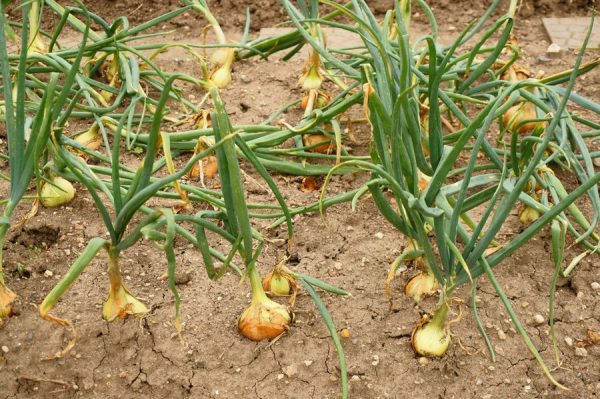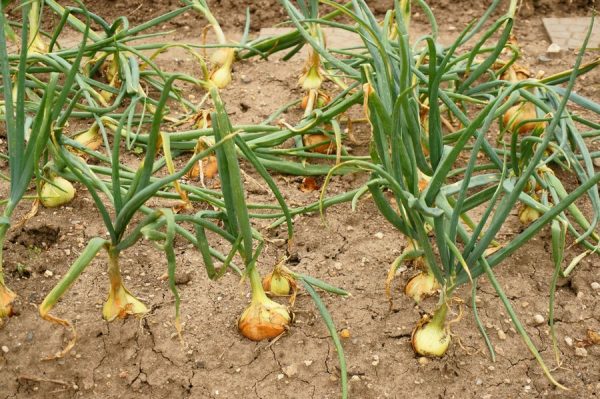This year, our onion feathers dried out and lay down in the garden back in July. Is it worth watering this onion so that it grows or is it time to dig it up?
There is only one reason for this behavior of the onion: you provoked premature ripening of the bulbs. During the active growing season, onions require constant moisture; there should be no changes in soil moisture.There is moisture - the onion grows, its deficiency occurs - the growth of the feather stops, the bulbs begin to “dress” - ripen. It is enough to be late with watering for 1-2 days for the process to become irreversible.
Take a closer look at your garden bed: if there are no young growing leaves on the plants, it means they have finished their growing season. It makes no sense to continue watering onions that have already dried out, much less fallen. If there are still young leaves, continue to water - the bulbs will still grow.
Thickened sowing could affect the premature ripening of onions. In "crowded conditions" plants get less water, their feathers stretch out in search of light, and do not grow as strong as they should be. One strong wind or rain is enough for the onion leaves to fall down and not rise again.
In addition, there are varieties of onions with a thin neck. On the one hand, this is good. During the ripening period of the onion, the thin ganglion quickly dries out, closing the path of infection and moisture. This type of onion is stored better than one with a thick neck. But onions with a thin neck are not resistant to lodging and dry out faster.
In early onion varieties, the growing season lasts for 90-95 days. If it was planted in early May, then by mid-July it should already, as they say, reach the finish line - close to harvesting. And if the summer was hot and dry, this will further accelerate the ripening of the bulbs.
Next season, take into account your mistakes: thin out on time, ensure constant soil moisture in the onion beds. And be sure to feed the plants with potassium during the period of active growth. Onions respond well to spraying with potassium humate. The leaves become dark green, strong, resistant to diseases and premature lodging. It is also necessary to add potassium to the soil as part of complex fertilizers.



 CUCUMBERS NEVER GET SICK, I'VE BEEN USING ONLY THIS FOR 40 YEARS! I SHARE A SECRET WITH YOU, CUCUMBERS ARE LIKE THE PICTURE!
CUCUMBERS NEVER GET SICK, I'VE BEEN USING ONLY THIS FOR 40 YEARS! I SHARE A SECRET WITH YOU, CUCUMBERS ARE LIKE THE PICTURE! You can dig a bucket of potatoes from each bush. Do you think these are fairy tales? Watch the video
You can dig a bucket of potatoes from each bush. Do you think these are fairy tales? Watch the video
 How our fellow gardeners work in Korea. There is a lot to learn and just fun to watch.
How our fellow gardeners work in Korea. There is a lot to learn and just fun to watch. Eye trainer. The author claims that with daily viewing, vision is restored. They don't charge money for views.
Eye trainer. The author claims that with daily viewing, vision is restored. They don't charge money for views. A 3-ingredient cake recipe in 30 minutes is better than Napoleon. Simple and very tasty.
A 3-ingredient cake recipe in 30 minutes is better than Napoleon. Simple and very tasty. Therapeutic exercises for cervical osteochondrosis. A complete set of exercises.
Therapeutic exercises for cervical osteochondrosis. A complete set of exercises. Which indoor plants match your zodiac sign?
Which indoor plants match your zodiac sign? What about them? Excursion to German dachas.
What about them? Excursion to German dachas.